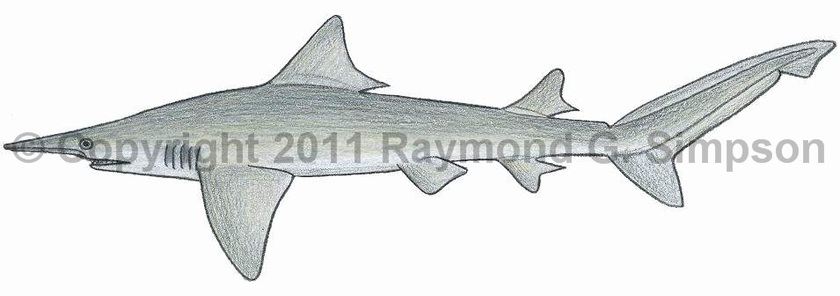
Common Name
Daggernose Shark
Year Described
Müller and Henle, 1839
Identification
Anteroposterior tooth rows: 24-28/24-28 on each side; 49-60/49-56 total
Vertebrae: 71-72 precaudal, 147-157 total
A small shark with a slender body. Snout extremely long and flattened, with a pointed tip. Eye tiny. Distance between nostrils 1.8-2.8 times in pre-oral distance. Nasal flaps rudimentary and very low. Upper labial furrows short but obvious. Interdorsal ridge is absent. Long preanal ridge absent. No keels on caudal peduncle. Gill slits long (2.8-3.6% TL). Teeth in upper jaw broad-based, with very narrow serrated cusps. Lower jaw teeth similar to upper but usually smooth. First dorsal fin high (8.9-10.1% TL) with a convex anterior margin, a concave rear margin, a pointed tip, and inserted over pectoral fin axil. Second dorsal fin smaller (4.6-4.8% TL) and inserted anterior to anal fin. Both dorsal fins with extended free posterior tips (second dorsal free tip less than height of second dorsal). Anal fin similar in size to second dorsal fin. Pelvic fin closer to anal fin than to dorsal fin. Pectoral fin very large and broad.
Color
Gray to grayish-yellow above, paler below. No markings on fins.
Size
Mature adults from 90-115cm TL. Newborns from 38-43cm. Maximum size to more than 152cm TL.
Habitat
Nearshore waters from 4-40m. Found in turbid waters around estuaries and mangrove swamps.
Range
South America: from Trinidad to Brazil.
References
Castro, J.I. 2011. The Sharks of North America. Oxford University Press, 640 pp.
Compagno, L.J.V. 2002. Sharks. In: Carpenter, K.E. (Editor) FAO Identification Guide for Fishery Purposes. The Living Marine Resources of The Western Central Atlantic. Volume 1: Introduction, mollusks, crustaceans, hagfishes, sharks, batoid fishes, and chimaeras. ASIH Special Publication No. 5. FAO, Rome.
Compagno, L., M. Dando, and S. Fowler. 2005. Sharks of the World. Princeton University Press, 480 pp.